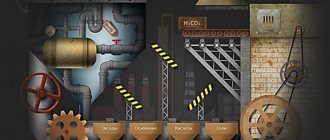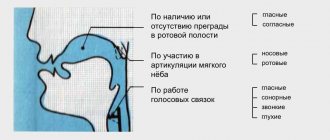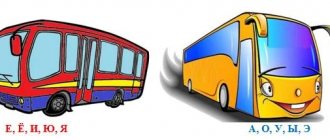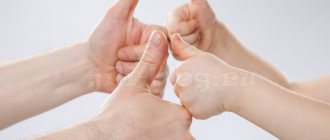Ronchopathy is being treated and this is already good. In addition, you can get rid of it in a very cheap way - with the help of tongue gymnastics. By choosing effective exercises, they will prevent its return after therapy. This technique is also suitable for preventive measures. A complex for the tongue is exactly what you need to do every day, then there will be a lasting effect.
So, with the help of physical education, you can significantly strengthen the muscles of the tongue, which your illness will not like. Of course, we are not talking about a complete treatment of apnea - what we offer is only part of a large therapeutic complex. Half an hour of exercise a day for a month, and you and your household will like the results.
Types, levels and forms of speech dysarthria in children
Table of types of disease by location of the lesion
| Name of the pathology form | Peculiarities |
| Cerebellar | Occurs when the cerebellum is involved in the process. Speech is drawn out, slurred, slow, the volume constantly changes, the child’s tongue trembles, he speaks with shouts, as if chanting slogans. Additional symptoms: poor balance, unsteady gait. |
| Bulbarnaya | It is caused by paralysis of the articulatory muscles, as well as the nerves - vagus, glossopharyngeal, ternary, sublingual and/or others. Children lack some reflexes, sucking and swallowing, facial expressions are impaired, and it is difficult for them to chew solid food. There is also increased salivation, simplification (all consonants “merge” into one fricative) and slurred sounds, a nasal, hoarse sound of the voice, sometimes its absence. |
| Pseudobulbar | Occurs with centralized paralysis (spastic) of muscles and their hypertonicity. Speech becomes monotonous, it is difficult for the child to lift the tip of the tongue, move it to the side, or hold it. There is increased salivation, soreness, and swallowing disorders (increased reflex). Speech is slurred, nasal, the pronunciation of hissing, whistling and tone sounds is sharply impaired. |
| Extrapyramidal | It occurs when the function of the subcortical nuclei is disrupted, and therefore received a second name – “subcortical”. Speech is slightly nasal, slurred, and slurred. There are involuntary muscle movements, facial expressions, and articulatory spasms. The timbre and strength of the voice changes, the pace of conversation is disrupted, and there are occasional guttural cries. |
| Cortical | Damage to those areas of the cerebral cortex that are responsible for articulatory muscles. Children pronounce words correctly in structure, but with impaired pronunciation of syllables. There is difficulty breathing during conversation and voice. |
| Cold | Manifests itself as one of the symptoms of myasthenia gravis (fatigue and weakness of striated muscles). Speech disruptions occur when the air temperature in the room where the child is located increases or decreases. |
Classification according to the degree of development of pathology:
- I (erased) - only a speech therapist can identify incorrect pronunciation during examination and examination, almost complete recovery is possible;
- II – pronunciation is clear, but defects are noticeable;
- III – the child is understood only by close people, strangers rarely;
- IV – even relatives do not understand the pronunciation or there is no speech, most often considered within the framework of cerebral palsy.
Important! The erased form is characterized by difficulty chewing solid food. Parents should not change their child's diet because of this. It is necessary to gradually accustom him to chew on the same basis as other people. Source: E.F. Arkhipova Erased dysarthria in children: a textbook for university students // M.: AST: Astrel: KHRANITEL, 2006, p.319
Articulation gymnastics
Be real artists, show your imagination.
Even a two-week-old baby will like it if, while dressing him for a walk, you tell him how a cow moos, how a rooster crows, how a dog barks. By the time you go through all the animals you know, the bewitched baby is already dressed. Over time, teach him to play with his tongue and blow into a tube (pipe, whistle, etc.). “Playing the pipe” is great entertainment for an 8-9 month old baby. When your baby gets a little older, start doing special play exercises. Choose a time when he is in a good mood. It’s best to do them in front of a mirror, although you can play while walking, having lunch (licking your lips, a plate, reaching your nose with your tongue, etc.), in line at the clinic, on the bus, or anywhere else. This does not require a lot of time and effort. The older the child gets, the more difficult the exercises become. (Recommended number of repetitions is 6-8 times).
Here are some examples
- Open your mouth wide (hot), close your mouth (cold)
- Puff up your cheeks, deflate your cheeks like a balloon.
- Lick your lips in a circle, reaching with your tongue forcefully to your nose, cheeks, chin (imagine that you are stained with jam).
- Lick the plate like a pussy does.
- Open your mouth slightly and drum your tongue on your upper teeth (like a drummer).
- Play baby elephant: stretch your lips forward with a tube, “make a trunk”; “give them some water,” smacking their lips slightly.
- Roll the nuts: with the mouth closed, the tip of the tongue alternately presses against the cheeks with tension, hard balls called “nuts” form on the cheeks.
- Play with a horse: click your tongue, then snort (you can play with a toy horse).
- Make a fence: smile with tension, exposing your teeth. Make a cup: stick out your tongue, give it the shape of a cup.
- Roll your tongue up, as if you were rolling a pancake, and press it with your upper teeth.
- Clean your teeth with a tongue (run the tongue along the upper teeth, then along the lower teeth).
- Play with a train: honk, “oooh”, lips with a tube (you can show a drawn or toy train).
- Show how the steamer hums: with your mouth slightly open, we make the sound “y-y-y”.
- Show your child a clock with a pendulum, let the child depict how it works, move your tongue in the same way: left and right, in the corners of your mouth.
Using these exercises, you can come up with and act out a fairy tale yourself. For example: “The tongue woke up in the morning, opened the window (open mouth), looked up - where is the sun? (stretch your tongue up towards your nose) - and began to look for it: looked to the left (stretch your tongue towards your left cheek), then to the right (stretch your tongue towards your right cheek),” etc. Use your imagination.
Causes and symptoms
The disease is provoked by a number of harmful factors:
- viral diseases of the expectant mother;
- pathologies of the placenta at the stage of intrauterine development;
- Rhesus conflict;
- fetal hypoxia;
- very rapid or slow labor with cerebral hemorrhage in the child;
- some birth injuries;
- prematurity;
- infections of the brain and its membranes, such as meningitis;
- Cerebral palsy (up to 85% of cases of dysarthria);
- TBI;
- hydrocephalus;
- severe intoxication;
- encephalitis. Source: L.I. Belyakova, Yu.O. Filatova Diagnosis of speech disorders // Defectology, 2007
Exercises to train the muscles of the tongue and normalize the type of swallowing
Exercise No. 1 “Clock”. The mouth is open, the tongue makes slow circular movements along the upper lip, then along the lower lip.
Exercise No. 2 “Punish the naughty tongue.” Place your tongue on your lower lip and slap it with your upper lip “na-na.”
Exercise No. 3 “We will paint the ceiling.” It's time to paint the rooms, they invited a molar, he comes to the old house with a new brush and bucket. Your tongues are a brush, your hard palate is the ceiling...
Exercise No. 4 Depict the operation of a jackhammer. DDDD...
Exercise No. 5 “Riders”. Sit astride a chair and, opening your mouth wide, click your tongue.
Symptoms and treatment
The main symptoms include the following:
- incomprehensible, slurred speech;
- spastic manifestations in the articulatory muscles (neck, lips, face, tongue are constantly tense, articulation is limited, lips are tightly closed);
- hypotonia of the articulatory apparatus (lips do not close, tongue lies motionless in the mouth, mouth is slightly open, increased salivation);
- dystonia of articulatory muscles (when a child tries to talk, his muscle tone goes from low to high);
- slurred pronunciation;
- in difficult cases, the child misses sounds, replaces them or pronounces them distorted; Source: O.Yu. Fedosova Features of sound pronunciation of children with mild dysarthria // Speech therapist in kindergarten, 2005, No. 2, pp. 36-41
- slowness of conversation;
- inability to speak (in severe forms);
- nasal voice without signs of a runny nose;
- change, omission, replacement of some sounds with others;
- fading of a phrase towards the end of its utterance, rapid breathing during a conversation due to lack of air;
- very high, almost “squeaky” voice;
- a fast or very slow flow of words, while the child cannot change the tone.
Developing phonemic awareness
Play audio cassettes for your child, draw attention to different sounds in your apartment and on the street (“Can you hear them knocking: knock-knock!”, “It’s the birds singing!”), buy different squeaking, rattling, sounding things (tumbler, musical carousel, xylophone and etc.).It is very important to “translate” the sounds of the surrounding world into speech (someone sneezed - say “apchhi”, dishes clinked - say “ding”).
Start doing special exercises. For the little one, of course, it will be just a game. You can take several sounding objects or musical instruments (tambourine, pipe, accordion, etc.). Teach a very young child to make sounds from them: ring, knock, rattle. Tap on different surfaces and let him hear how different the sounds are. If your baby is not yet holding a rattle, tie it to an arm or leg. Then teach him to play different instruments, knock on a drum (or on a pan). Bring the rattles to one ear or the other, let's listen to the clock, the phone. Sing and recite poetry to your baby. Use “funny sounds” and imitate animals. Read to him. At first, focus on rhythm and intonation.
When you hear a sound, ask: “What is that?”, then bring the child up and show what it sounded like. For a child after one year old, games for solving sounds are suitable. For example, show how different objects (musical instruments) sound. You can start with two, and very different in sound (pipe, drum). Then ask the child to guess what it sounded (until he saw it). Gradually make the task more difficult. You can also “speak” for different animal toys (or record on an audio tape: “quack-quack”, “oink-oink”, etc.), ask them to guess (show) who “talks” like that. Gradually make these games more difficult by using more sounds, and sounds that are harder to separate. Whisper a “secret” in your baby’s ear and let him whisper something to you too. And all this is in the form of a game, then the baby will imitate you.
It is not always easy for a small child to control his or her voice. Play with him, speaking softer and louder, controlling the pace. He also has to learn this. When telling fairy tales (for example, about seven kids), portray a wolf with a “thick” voice, then with a “thin” one, and let the baby himself try to repeat this. In other fairy tales, let him try to voice a bear, a lamb, a mosquito, use contrasts. Talk to your child either quietly (as if everyone is sleeping and you are sneaking through the forest), then loudly, with different intonations, while making up fairy tales as you go. Show a small and a large dog: how the small one barks (quietly), and how the big one barks (loudly), let the child repeat after you.
Read the poem (the first two lines in a quiet voice, hitting your finger quietly, the last two lines in a loud voice, loudly clapping your hands):
We gently beat finger on finger. We gently beat finger on finger. And then we clap our hands loudly. Let's clap our hands: bom-bom-bom.
Learn the poem (say the first line usually, the second quietly, the third usually, the fourth in a whisper: The mouse whispers to the mouse: “Are you rustling, aren’t you sleeping?” The mouse whispers to the mouse: “I’ll rustle more quietly.”
For an older child, the following tasks are suitable: “I will pronounce sounds, and you clap your hands when you hear a sound ... (for example, “M”), “I will name words, and you clap your hands when you hear a word with a sound ... (for example, "R").
For 5-6 year olds, the following task is suitable: “Replace the first sound in the word with “R.” What word did you get? Fox-...is, modeling-...epka, disk-...isk, etc.”
You can invent similar games yourself. Ask your child to walk on his toes to a quiet sound, to walk to a loud sound, to run to a very loud sound (for accompaniment, for example, by hitting a drum). Blindfold the baby, ring the bell, and let him try to determine where the sound is coming from. Teach your child to reproduce the rhythm. For example, clap your hands twice and ask your child to repeat after you. Knock on the table twice, then again after a pause, get the child to repeat after you. Clap the rhythm together and say two-syllable words: ma-ma, pa-pa, os-en, du-et, strong, many, etc. (then three-syllable words: you-so-ta, le-be-da, etc.).
You can make up your own words. Start doing all the exercises as early as possible. Of course, choose the simplest ones first, doing them casually: blow on the soup together or play a cat licking a plate. Don't be upset if everything doesn't work out the first time. Be patient, gentle and calm. Gradually complicate the tasks, presenting them certainly in the outline of a fairy tale or game. Do not forget to praise your baby more often. Sure success awaits you.
What to do? Treatment methods for the disorder
The child must undergo additional classes with a speech therapist (at home or in a special institution) on:
- development of motor skills;
- forming a conversation;
- honing diction;
- correcting the pronunciation of distorted sounds;
- expanding vocabulary;
- development of phonetic hearing;
- memorizing grammatical structure.
Against this background, drug therapy is carried out using nootropics. Medicines in this group specifically affect brain functions: stimulate mental activity, cognitive functions, increase learning abilities, and improve memory.
The package of measures also includes exercise therapy - articulation gymnastics to strengthen the facial muscles, massage, exercises with the hands and fingers.
Sources:
- E.F. Arkhipova. Erased dysarthria in children: a textbook for university students // M.: AST: Astrel: KHRANITEL, 2006, p. 319.
- L.I. Belyakova, Yu.O. Filatova. Diagnosis of speech disorders // Defectology, 2007.
- 3. O.Yu. Fedosova. Features of sound pronunciation of children with mild dysarthria // Speech therapist in kindergarten, 2005, No. 2, pp. 36-41.
The information in this article is provided for reference purposes and does not replace advice from a qualified professional. Don't self-medicate! At the first signs of illness, you should consult a doctor.
Developing speech breathing
Firstly, when you tell your child fairy tales, poems, for example, you mention the wind, teach the child to blow: blow in his face. Over time, he will begin to imitate you. Then you can also play, inviting the child to blow: give the baby a small piece of fluffy cotton wool, explain that this is a snowflake, it flies when the wind blows, you need to blow with your mouth, rounded lips, smoothly, and inhale through your nose.
Make a butterfly or an airplane out of paper, attach it to a string, and show your child how they will fly if you blow on it. You need to ensure that the exhalation is as long as possible.
Make a tree: cut out several strips of paper, glue it to a stick or pencil, the “wind” will sway the leaves. Such exercises also develop imagination.
Blow together on a piece of paper or a candle flame. It is important that the exhalation is not sharp, otherwise the candle will go out; you need to blow smoothly and easily.
Make (or buy) a pinwheel or toy windmill, teach your child to blow on the wings so that they spin.
Cut out birds from paper and place them at the very edge of the table. Command: “the birds have flown”, blow together, only once. The exhalation must be long so that they fly as far as possible.
Show your child how a dog breathes when it is hot: sticking out its tongue, noisily, quickly.
Teach your baby to blow hotly and also to warm his hands: let him inhale through his nose and exhale through his mouth, warming his hands raised to his lips.
It happens that children confuse the concepts of inhalation and exhalation, as well as inhalation and exhalation through the mouth and nose. Teach your child to smell a flower (you need to take an exaggerated breath through your nose, and then exhale with the sound “a-a”). Pick a faded dandelion and blow on it so that the fluffs fly off. Make sure that your baby puffs out his cheeks well and does not swallow or exhale air.
Draw the sea (for example, when telling fairy tales by A.S. Pushkin): as you inhale, smoothly raise your arms up, as you exhale, lower your arms, say a long “sh-sh-sh.” An older child can practice with soap bubbles or water. Let him blow into a tube (straw or pasta). By dipping a straw into the water, you can make a “real storm”. Pour water into a basin, you can launch boats, for example, paper ones. Then draw the wind. You need to blow slowly, pursing your lips like a tube, without puffing out your cheeks. Show your child how you do it. With an even exhalation, the boat moves smoothly through the water. Now blow intermittently: “p-p-p” and explain that a gusty wind blew. Let the child try to drive the boat to a certain place. Of course, this is an exercise for older children; it is not so easy to cope with such a task.
Exercises to train the muscles of the tongue and normalize the type of swallowing
Exercise No. 1 “Clock”. The mouth is open, the tongue makes slow circular movements along the upper lip, then along the lower lip.
Exercise No. 2 “Punish the naughty tongue.” Place your tongue on your lower lip and slap it with your upper lip “na-na.”
Exercise No. 3 “We will paint the ceiling.” It's time to paint the rooms, they invited a molar, he comes to the old house with a new brush and bucket. Your tongues are a brush, your hard palate is the ceiling...
Exercise No. 4 Depict the operation of a jackhammer. DDDD...
Exercise No. 5 “Riders”. Sit astride a chair and, opening your mouth wide, click your tongue.







